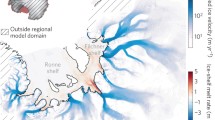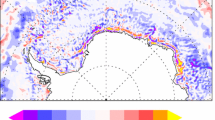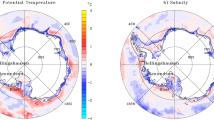Abstract
The Eastern Weddell Ice Shelves (EWIS) are believed to modify the water masses of the coastal current and thus preconditions the water mass formation in the southern and western Weddell Sea. We apply various ocean warming scenarios to investigate the impact on the temperature–salinity distribution and the sub-ice shelf melting in the Eastern Weddell Sea. In our numerical experiments, the warming is imposed homogeneously along the open inflow boundaries of the model domain, leading to a warming of the warm deep water (WDW) further downstream. Our modelling results indicate a weak quadratic dependence of the melt rate at the ice shelf base on the imposed amount of warming, which is consistent with earlier studies. The total melt rate has a strong dependence on the applied ocean warming depth. If the warming is restricted to the upper ocean (above 1,000 m), the water column (aside from the mixed surface layer) in the vicinity of the ice shelves stabilises. Hence, reduced vertical mixing will reduce the potential of Antarctic Bottom Water formation further downstream with consequences on the global thermohaline circulation. If the warming extends to the abyss, the WDW core moves significantly closer to the continental shelf break. This sharpens the Antarctic Slope Front and leads to a reduced density stratification. In contrast to the narrow shelf bathymetry in the EWIS region, a wider continental shelf (like in the southern Weddell Sea) partly protects ice shelves from remote ocean warming. Hence, the freshwater production rate of, e.g., the Filchner–Ronne Ice Shelf increases much less compared with the EWIS for identical warming scenarios. Our study therefore indicates that the ice-ocean interaction has a significant impact on the temperature-salinity distribution and the water column stability in the vicinity of ice shelves located along a narrow continental shelf. The effects of ocean warming and the impact of increased freshwater fluxes on the circulation are of the same order of magnitude and superimposed. Therefore, a consideration of this interaction in large-scale climate studies is essential.









Similar content being viewed by others
References
Beckmann A, Goosse H (2003) A parametrization of ice shelf - ocean interaction for climate models. Ocean Model 5:157–170
Fahrbach E, Harms S, Rohardt G, Schröder M, Woodgate RA (2001) Flow of bottom water in the northwestern Weddell Sea. J Geophys Res 106(C2):2761–2778
Fahrbach E, Hoppema M, Rohardt G, Schröder M, Wisotzki A (2004) Decadal-scale variations of water mass properties in the deep Weddell Sea. Ocean Dyn 54:77–91
Fahrbach E, Peterson RG, Rohardt G, Schlosser P, Bayer R (1994) Suppression of bottom water formation in the southeastern Weddell Sea. Deep-Sea Res 41(2):389–411
Fahrbach E, Rohardt G, Scheele N, Schröder M, Strass V, Wisotzki A (1995) Formation and discharge of deep and bottom water in the nortwestern Weddell Sea. J Mar Res 53(4):515–538
Gill AE (1973) Circulation and bottom water mass formation in the Weddell Sea. Deep-Sea Res 20:111–140
Goosse H, Fichefet T (1999) Importance of ice-ocean interactions for the global ocean circulation: a model study. J Geophys Res 104(C10):23337–23355
Gordon AL (1978) Deep Antarctic convection west of Maud Rise. J Phys Oceanogr 8:600–612
Gouretski V, Jancke K, Reid J, Swift J, Rhines P, Schlitzer R et al (1999) WOCE hydrographic programme special analysis centre, Atlas of Ocean Sections. CD-ROM
Grosfeld K, Sandhäger H (2004) The evolution of a coupled ice shelf – ocean system under different climate states. Glob Planet Change 42:107–132. doi:10.1016/j.gloplacha.2003.11.04
Hellmer HH (2004) Impact of Antarctic ice shelf basal melting on sea ice and deep ocean properties. Geophys Res Lett 31:1–4, L10307. doi:10.1029/2004GL019506
Hellmer HH, Jacobs SS, Jenkins A (1998) Oceanic erosion of a floating Antarctic glacier in the Amundsen Sea. In: Jacobs SS, Weiss RF (eds) Ocean, ice, and atmosphere: interactions at the antarctic continental margin. Antarctic research series, vol 75. Americal Geophysical Union, Washington, DC, pp 83–99
Holland MD, Jenkins A (1999) Modeling thermodynamic ice-ocean interaction at the base of an ice shelf. J Phys Oceanogr 29:1787–1800
Holland PR, Jenkins A, Holland DM (2008) The response of ice shelf basal melting to variations in ocean temperature. J Climate 21:2558–2572
IPCC (2007) The physical science basis. contribution of working group i to the fourth assessment report of the intergovernmental panel on climate change. In: Solomon S, Qin D, Manning M, Chen Z, Marquis M, Averyt KB, Tignor M, Miller HL (eds) Climate change 2007. Cambridge University Press, Cambridge, United Kingdom and New York, NY, USA, p 1pp
Jacobs SS, Hellmer HH, Jenkins A (1996) Antarctic ice sheet melting in the Southeast Pacific. Geophys Res Lett 23(9):957–960
Jenkins A, Vaughan DG, Jacobs SS, Hellmer AH, Keys JR (1997) Glaciological and oceanographic evidence of high melt rates beneath Pine Island Glacier, West Antarctica. J Glaciol 43(143):114–121
Kottmeier C, Sellmann L (1996) Atmospheric and oceanic forcing of Weddell Sea ice motion. J Geophys Res 101(C9):20809–20824
Lange MA, Blindow N, Breuer B, Grosfeld K, Kleiner T, Mohrholz CO et al (2005) Numerical model studies of Antarctic ice-sheet – ice-shelf – ocean systems and ice caps. Ann Glaciol 41:111–120
MacAyeal DR, Scambos TA, Hulbe CL, Fahnestock MA (2003) Catastrophic ice-shelf break-up by an ice-shelf-fragment-capsize mechanism. J Glaciol 49(164):22–35
Manabe S, Stouffer RJ (1994) Multiple-century response of a coupled ocean-atmosphere model to an increase of atmospheric carbon dioxide. J Climate 7:5–23
Núñez-Riboni I, Fahrbach E (2009) Seasonal variability of the Antarctic Coastal Current and its driving mechanisms in the Weddell Sea. Deep-Sea Res 56(11):1927–1941
O’Farrell SP, McGregor JL, Rotstayn LD, Budd WF, Zweck C, Warner R (1997) Impact of transient increases in atmospheric CO2 on the accumulation and mass balance of the Antarctic Ice Sheet. Ann Glaciol 25:137–144
Oppenheimer M (1998) Global warming and the stability of the West Antarctic Ice Sheet. Nature 393:325–332
Payne AJ, Holland PR, Shepherd AP, Rutt IC, Jenkins A, Joughin I (2007) Numerical modeling of ocean-ice interactions under Pine Island Bay’s ice shelf. J Geophys Res 112(C10019). doi:10.1029/2006JC003733
Rignot E, Casassa G, Gogineni P, Krabill W, Rivera A, Thomas R (2004) Accelerated ice discharge from the Antarctic Peninsula following the collapse of Larsen B ice shelf. Geophys Res Lett 31:l18401. doi:10.1029/2004GL020697
Rignot E, Vaughan DG, Schmeltz M, Dupont T, MacAyeal D (2002) Acceleration of Pine Island and Thwaites Glaciers, West Antarctica. Ann Glaciol 34:189–194
Robertson R, Visbeck M, Gordon AL, Fahrbach E (2002) Long-term temperature trends in the deep waters of the Weddell Sea. Deep-Sea Res 49(21):4791–4806
Rott H, Skvarca P, Nagler T (1996) Rapid collapse of Northern Larsen Ice Shelf, Antarctica. Science 271(5250):788–792
Scambos TA, Bohlander JA, Shuman CA, Skvarca P (2004) Glacier acceleration and thinning after ice shelf collapse in the Larsen B embayment, Antarctica. Geophys Res Lett 31:l18402. doi:10.1029/2004GL020670
Scambos TA, Hulbe C, Fahnestock M, Bohlander J (2000) The link between climate warming and break-up of ice shelves in the Antarctic Peninsula. J Glaciol 46(154):516–530, l18402. doi:10.1029/2004GL020670
Shepherd A, Wingham D, Payne T, Skvarca P (2003) Larsen Ice Shelf has progressively thinned. Science 302(5646):856–859
Shepherd A, Wingham DJ, Rignot E (2004) Warm ocean is eroding West Antarctic Ice Sheet. Geophys Res Lett 31:L23402. doi:10.1029/2004GL021106
Smedsrud LH (2005) Warming of the deep water in the Weddell Sea along the Greenwich meridian: 1977–2001. Deep-Sea Res 52:241–258. doi:10.1016/j.dsr.2004.10.004
Swingedouw D, Fichefet T, Huybrechts P, Goosse H, Driesschaert E, Loutre MF (2008) Antarctic ice-sheet melting provides negative feedbacks on future climate warming. Geophys Res Lett 35(17):1–2
Thoma M, Grosfeld K, Lange MA (2006a) Impact of the Eastern Weddell Ice Shelves on water masses in the eastern Weddell Sea. J Geophys Res 111(C12010). doi:10.1029/2005JC003212
Thoma M, Grosfeld K, Lange MA (2006b) The impact of ocean warming and ice shelf geometry on the basal melt rate of the FRIS. FRISP Report 17
Thoma M, Jenkins A, Holland D, Jacobs S (2008) Modelling Circumpolar Deep Water intrusions on the Amundsen Sea continental shelf, Antarctica. Geophys Res Lett 35:L18602+
Timmermann R, Beckmann A, Hellmer HH (2001) The role of sea ice in the fresh water budget of the Weddell Sea. Ann Glaciol 33:419–424
Vaughan DG, Marshall GJM, Parkinson CWC, Mulvaney R, Hodgson DA, King JC et al (2003) Recent rapid regional climate warming on the Antarctic Peninsula. Clim Change 60(3):243–274
Vaughan DG, Spouge JR (2002) Risk estimation of collapse of the West Antarctic Ice Sheet. Clim Change 52:65–91. doi:10.1023/A:1013038920600
Acknowledgements
This work is part of the German CLIVAR/marin-project. Founding by the Bundesministerium für Bildung, Wissenschaft, Forschung und Technologie (bmb+f) der Bundesrepublik Deutschland, contract 03F0377C, is gratefully acknowledged. The authors wish to thank Povl Abrahamsen for the recovery of some lost data, Andrea Bleyer for proof reading as well as Hartmut Hellmer, Angelika Humbert and three anonymous reviewers for helpful suggestions which improved the manuscript.
Author information
Authors and Affiliations
Corresponding author
Additional information
Responsible Editor: Karen J. Heywood
Rights and permissions
About this article
Cite this article
Thoma, M., Grosfeld, K., Makinson, K. et al. Modelling the impact of ocean warming on melting and water masses of ice shelves in the Eastern Weddell Sea. Ocean Dynamics 60, 479–489 (2010). https://doi.org/10.1007/s10236-010-0262-x
Received:
Accepted:
Published:
Issue Date:
DOI: https://doi.org/10.1007/s10236-010-0262-x




